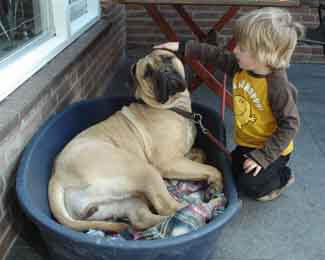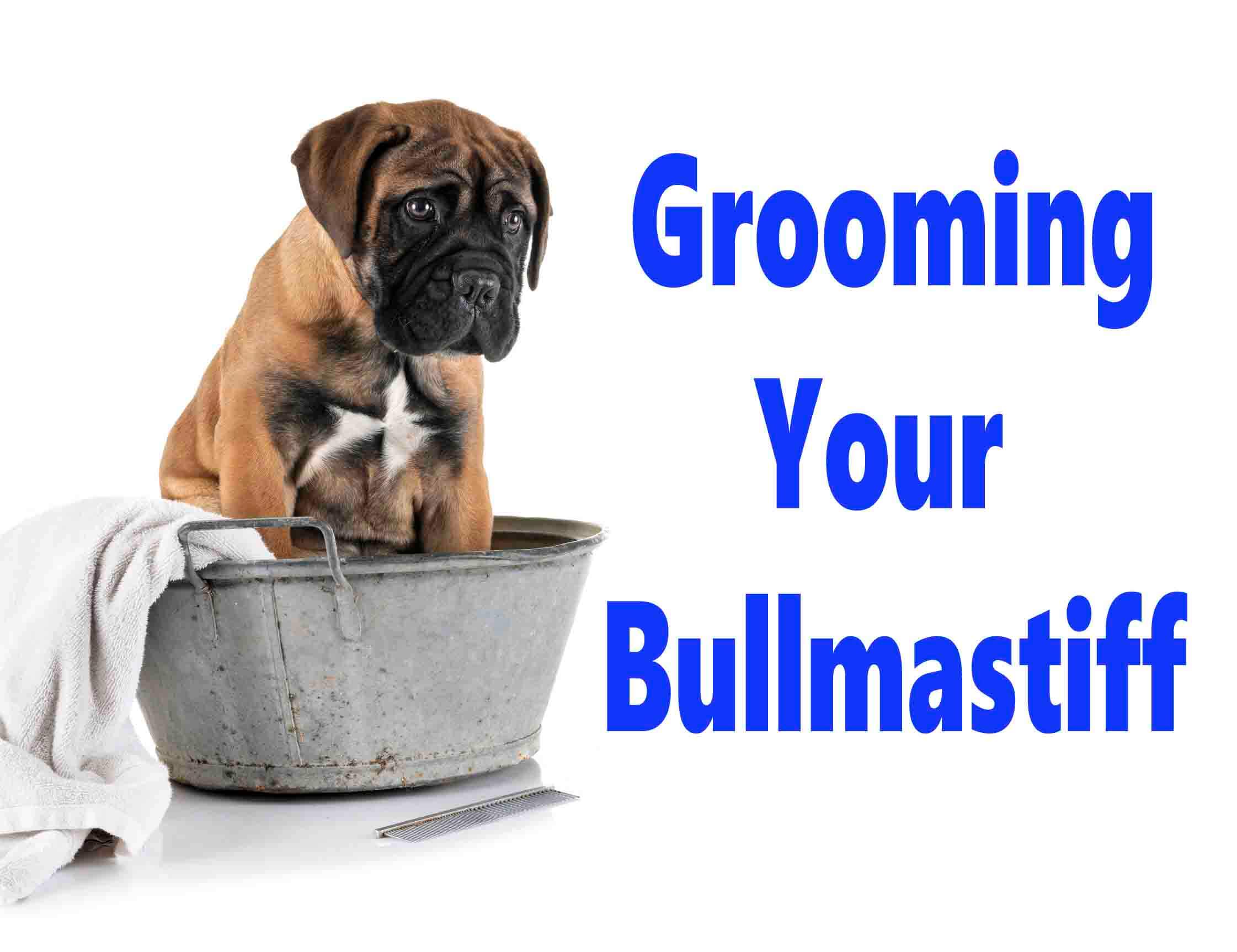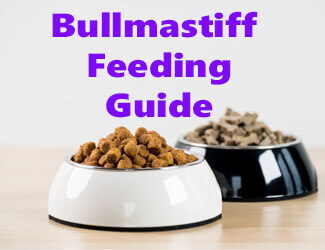12 Bullmastiff
Temperament Traits
...And A Few Tips On How To Manage Them
by Ken Alden
To the outside world, the Bullmastiff comes off as
intimidating. They can weigh up to 130 pounds and can be over 27 inches tall
(at the shoulders), making them one of the largest dog breeds in the world.
Yet, there seems to be a disconnect between their physical appearance and their
temperament.
Bullmastiff Temperament Traits Include...
- For such a large breed, the Bullmastiff is truly a gentle giant.
- They’re loyal to their own pack and are extremely protective of their families.
- They’re not so energetic, but will always be a source of support when you need them.
- They don’t do well with dogs and cats, but they’ll be your friend.
There’s a lot more to the Bullmastiff than what meets the eye. So, we’re going to go over 12 of the most significant temperament traits and personality behaviors that you can expect from a Bullmastiff. Read More Below...
Pro-tip: Ever try lifting a Bullmastiff? Their weight can hurt not only your back but their joints when they hop down from cars, sofas or even your bed. To protect your back and theirs check out the best Mastiff ramps on Amazon.com now.

Bullmastiffs Are Loyal
The loyalty of the Bullmastiff is practically unmatched. But, to understand why the Bullmastiff is so loyal, we have to go back to the beginning of the breed. That brings us across the pond to England in the 19th century.
The Bullmastiff was specifically bred by
gamekeepers looking to keep poachers off of their land. The end product was a
dog so loyal to its owner and its property that it would pin poachers down at
the slightest sign of trespass.
A Tail of Two Breeds...
A lot of the loyalty seen in this breed comes down to genetics. In fact, the Bullmastiff comes from two of the most loyal dog breeds: Bulldogs and Mastiffs.
But, what exactly does this mean for the Bullmastiff?
Once the Bullmastiff forms an attachment with his humans, he’ll stick by their side for life. That’s because the dog treats his family members as part of his pack, willing to put his own safety on the line to protect his family.
So, if you’re looking for a dog that’ll have
your back 100% of the time, the Bullmastiff is definitely the way to go.
Bullmastiffs Are Docile
Despite their ferocious appearance, Bullmastiffs are actually some of the most docile dog breeds out there. Even though they’ll pin a trespasser down in a heartbeat, they’re typically pretty shy, even with their families.
The breed doesn’t usually bark and tends to be rather quiet in nature. That’s why many proud owners would describe their Bullmastiff as having a “laid back personality.” This is part of the reason that the Bullmastiff is so easy to train.
Training Your Bullmastiff...
Since the Bullmastiff is so submissive, learning the rules of the house and new commands will be a breeze. But, you need to take a strategic approach to the training process, as this breed isn’t the most focused dog.
The Bullmastiff tends to get bored rather easily, especially during training. So, the best way to train your brand new Bullmastiff puppy is by breaking training sessions down into short ten or 15-minute blocks.
For even better results, try adding a little
food to the training routine. Bullmastiffs tend to be really food motivated and
will do anything to please you (and for a little treat).
Pro-tip: Bullmastiff anxiety, aggression, destructive chewing, jumping up, fearfulness, and other behaviors can be controlled with the right training program.
Here’s a great course that
addresses these issues along with many other dog training basics: Check it out now!
Bullmastiffs Are Reserved
Another Bullmastiff temperament trait is they're typically a very friendly dog with his family, but your pal might be a little untrusting and suspicious of new people. So, don’t be surprised if your Bullmastiff holds back his true personality a little when you’re bringing new friends around or if a stranger is at the door.
Simply put: Your Bullmastiff won’t show affection to people he doesn’t know. It might take some time for him to open up and be more like himself around strangers, so consistency with new people is the best approach.
Socializing Your Bullmastiff...
While you can’t control the nature and the genetics of the Bullmastiff, you can address his behaviors. It would be a great idea to get your Bullmastiff puppy enrolled in puppy classes when he’s a few months old.
Puppy classes are great for teaching your pooch the basic commands and how to walk on a leash. They’re also your Bullmastiff’s first interaction with other puppies, owners, and even a dog trainer.
Once the puppy classes are over, you need to
continue socializing your Bullmastiff. That means frequent exposure to other
dogs and people, so he becomes more trusting of outsiders.

Here's a great article of ours covering more about the subject of Mastiff Socialization and best practices when socializing your pooch.
Bullmastiffs Are Devoted
There’s no doubt about it; a Bullmastiff is 100% committed to his family. So much so, in fact, that he’ll view you as a member of his pack for life and will do just about anything to please you and keep you happy.
Since the breed tends to be rather docile, his devotion is quite clear from the moment you pick him up from the breeder. The Bullmastiff values his relationship with you over anyone and anything else. bullmastiff temperament traits
A Little Dependent...
Any dog depends on his owner to keep him fed, give him water, and bring him for walks outside. But, the Bullmastiff’s world (which is centered around you) tends to get a little lonely when you’re not around.
So, it’s not unusual for this breed to exhibit a little destructive personality when they’re cooped up in the house alone for too long. You might come home to a trashed house, chewed furniture, or the garbage can ripped apart.
The best thing you can do is limit the amount
of time you spend away from your Bullmastiff. Also, make the extra effort to
leave him chew toys and treats when you do plan on being away for a couple of
hours.
Bullmastiffs Are Protective
Bullmastiffs are actually some of the best guard dogs out there. A simple look at their genetics will explain why, as they were bred to protect land and attack poachers the second they found their way onto the Bullmastiff’s property.
From the early days, this breed was trained to pin intruders down until further help arrived. However, it’s not in the Bullmastiff’s instincts to bite. They depend on you to take over once the intruder has been restrained.
Keeping Him Controlled...
When it comes to Bullmastiff temperament traits, it can be a little tricky owning one of these dogs. You enjoy the protective temperament of your Bullmastiff on a daily basis, but the intense fear and aggression that occurs when he encounters a stranger can be a little scary for you.
Because you just don’t know how your Bullmastiff will react to new people, having your control over him is one of the best things you can do. That means buying a durable harness and always having him leashed when he’s outside.
There’s nothing that says that he’ll ever
attack, but it’s best to play on the safe side when it comes to large breeds
with powerful bite forces.
Bullmastiffs Are Alert
Bullmastiffs don’t just make good guard dogs. They also make great watchdogs too. That’s a direct result of their innate desire to protect you and your property, willing to put in the hours to keep an eye on the place.
The breed doesn’t usually respond quickly to dangers, but they will notice when things are amiss. So, don’t be surprised when your Bullmastiff begins barking like crazy right before the doorbell rings.
Letting You Know of Danger...
Even if you train your Bullmastiff not to bark, he will when he feels it is necessary. That’s most likely to occur when he feels there’s an incoming threat to the home.
Your pal will probably alert you of any dangers with a hearty bark or a growl. When he’s in this state, you might notice his tail standing at attention and the small hairs on his back standing up too!
As a watchdog, his job is to alert you of
any danger and then let you take it from there. So, be prepared to tag-team a
potential intruder if your Bullmastiff begins with an unusual barking fit.
Pro-tip: Bullmastiff's (and their owners) love dog crates…and for good reasons. Crates keep dogs from mischief while you're away, are perfect for house training, for traveling by car, and provide the dog a place to de-stress. Check out the best Mastiff crates on Amazon.com now.
Bullmastiffs Are Courageous
The Bullmastiff knows his size, and he’s not afraid to use it to his own advantage. Though Bullmastiffs aren’t exactly quick to defend the home when an intruder approaches, he’ll pounce without fear if there’s enough taunting.
That definitely comes from his Bulldog ancestry. Despite being small, the Bulldog is quite bulky and uses his weight and incredible muscular strength to gain a strategic advantage over a threat or an intruder.
No Limits...
The incredible courage of the Bullmastiff means he won’t even think about backing down from a fight when provoked. After all, his job as the family’s guardian is to keep you safe, and he’s willing to put his own life on the line to protect you.
Training is key, however. As much as you enjoy your dog willing to take one for the team, having too much courage might cause him to perceive just about anything as a threat.
As far as Bullmastiff temperament traits, don’t expect to just bring your dog home and expect him to know the rules of the land. If you truly want him to be
your family’s guard dog, you need to train him what to look out for and what
actually warrants a physical attack.
Bullmastiffs Are Calm
For a dog that’s so willing to pin down a 200-pound man with ease, the Bullmastiff has one of the calmest personalities out there. Combine the overwhelming calmness with the shyness, and you’ve got yourself the perfect companion animal.
In all honesty, it takes a lot to get a Bullmastiff worked up and ready to fight. Your Bullmastiff would much rather hang around the house and even cuddle up on the couch than go outside and fight off intruders.
When Calmness Becomes Laziness...

So, you love lying in bed with your Bullmastiff or having him rest his head on you while you’re watching TV. But, at the same time, his activity level is really low, and he almost never moves unless he has to.
Large dog breeds (like Mastiffs, Bulldogs, and of course, the Bullmastiff) are very prone to obesity. Yet, obesity can also be even harder on their joints and make conditions like hip dysplasia more common.
That’s why you need to make it a point to get
your Bullmastiff enough exercise on a daily basis. An hour a day should be
fine, but you’re best off splitting it into two or three walks, so he doesn’t
get too tired or overheated.
Bullmastiffs Are Powerful
Let’s talk about the sheer size of the Bullmastiff. This breed can grow to be up to 130 pounds and up to 27 inches at the shoulders. That undoubtedly makes the Bullmastiff one of the largest and most powerful dogs in the world.
With such a large size comes incredible bite force and an impressive ability to pin people down. So, you want to make it a point to train your Bullmastiff to know his size and to be more gentle with those around him.
Training a Gentle Giant...
We get it, the last thing you want is a dog breed that’ll knock your children over, even if they’re just trying to play. The good news is, Bullmastiffs generally seem to be pretty good with children and protect them as their own.
The best thing you can do is teach your dog the basic commands so you can have better control over him at all times. You should also limit how rough you play with your Bullmastiff starting when he’s a puppy, as you don’t want to train him to play rough.
The last thing you want is a dog that truly
doesn’t know his own strength. So, keep an eye on any interactions your
Bullmastiff has with children and remind him how to play.
Bullmastiffs Are Reliable
Even if your Bullmastiff doesn’t jump at the opportunity to pin a stranger down, that doesn’t mean that he’s not paying attention or that he doesn’t care. You can 100% count on your Bullmastiff to be there and protect you when you really need it.
When it comes to reliability, the Bullmastiff really has it all. He’ll let you know whenever there’s a threat to the home, pin an intruder down if it comes to that, and will keep you safe from strangers if he sees a threat.
Other Ways He’s Reliable...
Once you train your Bullmastiff, he’ll stick to the rules and commands and won’t disappoint you. Well, as long as you’re making sure you’re spending enough time with him.
He’ll do pretty well with your children and won’t have a hard time realizing that he’s far bigger than them and should be gentle. You just have to make sure you train him as such.
If you see what we’re getting at here, the best way to guarantee reliability in your Bullmastiff is by training him to be reliable. Please don’t expect to bring home a watchdog, guard dog, or already-trained puppy without putting in any work.
Also, make it a point to keep up with
training. You don’t have to spend 15 minutes a day training him once he’s an
adult, but it’s a good idea to throw in some brief training sessions here and
there to keep him focused. bullmastiff temperament traits
Bullmastiff Temperament With Other Dogs
Bullmastiffs can be good with other dogs, but you should definitely avoid bringing home another dog of the same sex. No matter what the breed or size, Bullmastiffs will compete to be the alpha, and it could turn into frequent physical altercations.
So, you might be able to bring home a dog of the opposite sex and hope it turns out well, but there are no guarantees. The last thing you want to do is leave the two unattended and come home to what looks like a crime scene.
The best way to prepare your Bullmastiff for
another dog is by keeping him socialized properly since puppyhood and training
him how to behave and play with dogs.
Bullmastiff Temperament With Cats
Unfortunately, the Bullmastiff has a rather high prey drive, meaning cats are probably one of the worst pets to have when you own a Bullmastiff. He’ll see any interaction with a cat as a chance to chase the cat around and even pin the cat down.
But, obviously, this isn’t guaranteed for all Bullmastiff-cat interactions. Your Bullmastiff might be so docile that he sees the cat as the threat and does his best to avoid the cat when waltzing around the house. You might even catch them cuddling when you’re not looking.
We’d suggest not even chancing it. Even though
cats tend to run the house, a cat doesn’t stand a chance against a potentially
130-pound dog.
Bullmastiff Temperament Traits...Final Thoughts
The Bullmastiff is a great dog breed temperament wise and is fantastic with families and children. They make great guard dogs and watchdogs and will surely have your back if you ever need it. Here are some things to know about the Bullmastiff before you bring one home.
- They don’t get along well personality wise with cats or dogs of the same sex, so a single dog household would be best for them.
- They’re loyal and protective, so you need to teach them how to be okay with strangers and new people.
- They’re very quiet and simply want to spend as much time with you as possible.
- They’re extremely easy to train and will do anything to impress
you.
Return to the top of this Bullmastiff Temperament Traits page

About the Author...
Ken Alden, a dedicated Mastiff owner for over eight years, is acclaimed for his expertise in care, grooming, and training. Read more About Me and my dog Shadow.
- Mastiff Guide Home ›
- Bullmastiffs ›
- Bullmastiff Temperament Traits






